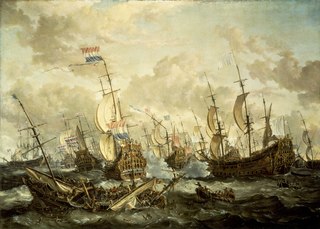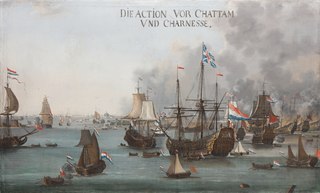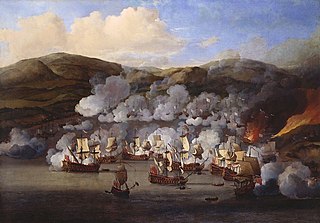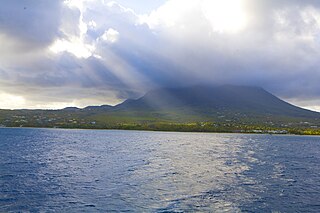
The Second Anglo-Dutch War, or Second Dutch War, began on 4 March 1665, and concluded with the signing of the Treaty of Breda on 31 July 1667. One in a series of naval conflicts between England and the Dutch Republic, its causes were a combination of political differences and commercial disputes.

The Four Days' Battle was a naval engagement fought from 11 to 14 June 1666 during the Second Anglo-Dutch War. It began off the Flemish coast and ended near the English coast, and remains one of the longest naval battles in history.

The Raid on the Medway, during the Second Anglo-Dutch War in June 1667, was a successful attack conducted by the Dutch navy on English warships laid up in the fleet anchorages off Chatham Dockyard and Gillingham in the county of Kent. At the time, the fortress of Upnor Castle and a barrier chain called the "Gillingham Line" were supposed to protect the English ships.

The Battle of Plymouth was a naval battle in the First Anglo-Dutch War. It took place on 16 August 1652 and was a short battle, but had the unexpected outcome of a Dutch victory over England. General-at-Sea George Ayscue of the Commonwealth of England attacked an outward bound convoy of the Dutch Republic commanded by Vice-Commodore Michiel de Ruyter. The two commanders had been personal friends before the war. The Dutch were able to force Ayscue to break off the engagement, and the Dutch convoy sailed safely to the Atlantic while Ayscue sailed to Plymouth for repairs.
Anthony or Anthonij Colve was a Dutch captain of Marines and the Governor-General of New Netherland during a brief restoration of Dutch rule in New Netherland during the Third Anglo-Dutch War.

Cornelis Evertsen the Youngest was a Dutch naval officer from Vlissingen who served as Lieutenant Admiral of Zeeland and Supreme Commander of the Confederated Dutch Navy. Of a family that included several other naval admirals, including his father, Evertsen is noted for his distinguished service during the Second Anglo-Dutch War, Third Anglo-Dutch War, the Franco-Dutch War, the Glorious Revolution invasion, and the Battle of Beachy Head during the Nine Years' War.
Events from the year 1667 in England. Dates are given in Old Style. As of the start of this year, the Gregorian calendar in use by the Dutch Republic and elsewhere on the continent is 10 days ahead of the Julian calendar in use in England.
The naval history of the Netherlands dates back to the 15th century. As overseas trade was a traditional cornerstone of the Dutch economy, naval defence was indispensable for the protection of commercial interests.

Abraham Crijnssen was a Dutch naval commander, notable for capturing the English colony in Suriname in 1667 during the Second Anglo-Dutch War, resulting in the establishment of a long-term colony under Dutch control. The minesweeper HNLMS Abraham Crijnssen and the frigate HNLMS Abraham Crijnssen have been named after him.
The maritime history of England involves events including shipping, ports, navigation, and seamen, as well as marine sciences, exploration, trade, and maritime themes in the arts of England. Until the advent of air transport and the creation of the Channel Tunnel, marine transport was the only way of reaching the rest of Europe from England and for this reason, maritime trade and naval power have always had great importance. Prior to the Acts of Union in 1707, the maritime history of the British Isles was largely dominated by England.

The Battle of Martinique took place off the Caribbean island of Martinique from 30 June to 7 July 1667, towards the end of the Second Anglo-Dutch War. A French fleet commanded by de la Barre was virtually destroyed by a Royal Navy squadron under Sir John Harman. Victory meant the English restored their position in the region shortly before the Treaty of Breda ended the war on 31 July 1667.

The Battle of Nevis on 20 May 1667 was a confused naval clash in the Caribbean off the island of Nevis during the closing stages of the Second Anglo-Dutch War. It was fought between an English squadron and an Allied Franco-Dutch fleet intent on invading the island. The battle ended up being an English victory in that it prevented a Franco-Dutch invasion of Nevis.

The Recapture of Fort Zeelandia or the Seizure of Fort Zeelandia was a minor military action on 13 October 1667 at the end of the Second Anglo-Dutch War in which an English force under command of Rear Admiral Sir John Harman assaulted and took by force the Dutch settlement and fortress of Zeelandia under Maurits de Rame. The English occupied the area but only for a short while as news of the peace of Breda arrived. The Dutch had captured the Zeelandia earlier in the year, and the English recapture was the last battle before the war's end between England and the Dutch Republic.
Robert le Frichot des Friches, sieur de Clodoré was a French governor of Martinique from 1665 to 1667. He was an energetic and effective leader during the Second Anglo-Dutch War, in which France was an ally of the Dutch from the start of 1666. He used Caribs as auxiliaries, and helped take several islands in the Antilles from the English.

Admiral Sir John Harman was an English officer of the Royal Navy, who served first under the Commonwealth, then Charles II following the 1660 Stuart Restoration.
Claude de Roux, chevalier de Saint-Laurent was a French soldier, a chevalier of the Knights Hospitaller, who was governor of the colony of Saint Christophe on Saint Christopher Island from 1666 to 1689. He took office in the Second Anglo-Dutch War (1665–67), when the French expelled the English from the island, and left office early in the Nine Years' War (1688–97), when the English expelled the French from the island.

The Dutch Raid on North America took place from December 1672 to February 1674 during the Third Anglo-Dutch War, a related conflict of the Franco-Dutch War. A naval expedition led by Cornelis Evertsen the Youngest and Jacob Binckes attacked English and French possessions in North America.
The Invasion of Surinam was a Dutch attempt to capture the English held colony of Surinam in February 1667. The Dutch under the command of Abraham Crijnssen captured the colony without much resistance.

The Second Battle of the James River, also known as the Battle of Lynnhaven Bay was a naval battle between a Dutch fleet under joint command of admirals Cornelis Evertsen the Youngest and Jacob Binckes and an improvised English squadron on 12 and 13 July 1673 in the Hampton Roads near the James River, during the Third Anglo-Dutch War.

On 9 August 1673, during the Third Anglo-Dutch War a combined Dutch fleet commanded by Cornelis Evertsen the Youngest of the Admiralty of Zeeland and Jacob Binckes of the Admiralty of Amsterdam recaptured New York, which had been English since the Peace of Breda of 1667. The town of New York was re-christened "New Orange" and New Netherland was re-established as a Dutch colony under governor-general Anthony Colve. The Dutch Republic, however, returned the colony to English rule under the Treaty of Westminster (1674), in exchange for the colony of Suriname, which eventually led to the replacement of governor Colve by governor Edmund Andros on 10 November 1674 (N.S.)













